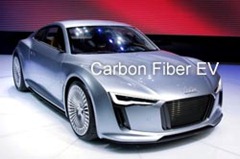 Electric cars have shown strong response, worldwide. But all EV manufacturers have faced one common problem: Poor battery life. Even though our technologies have evolved a lot over years, little progress has been made by battery industry.
Electric cars have shown strong response, worldwide. But all EV manufacturers have faced one common problem: Poor battery life. Even though our technologies have evolved a lot over years, little progress has been made by battery industry.
BMW is hoping to change this. Most manufacturers rely on traditional — and heavy– steel car bodies, but the BMW hopes that carbon fiber components could lead electric cars into the future.
Mitsubishi has released its first electric car series under the rather uninspiring model designation i-MiEV. It’s a simply furnished compact car with an oval body and lithium-ion batteries under the floor panel. With one charge of the battery, the vehicle can travel 100 kilometers (62 miles) in summer or 60 kilometers (37 miles) in winter. It costs ?34,390 ($45,240).
Nissan’s electric car, the Leaf — set to hit the German market next year — faces the same cost-benefit plight. Even so, European automobile journalists saw fit to name the Leaf their “Car of the Year.”
Car manufacturers are building sedans and high class models of electric cars, making them bulky and inefficient for battery lives.
BMW is attempting to break the cycle. BMW, 3 years from now,will launch a new construction type to Cars called as Megacity Vehicle (MCV), which won’t contain steel or aluminum bodywork. Instead, it will have a light alloy frame in the car floor and a body made of carbon fiber-reinforced polymer (CFRP).
CFRP is a dull black material which has a chemical structure similar to that of diamonds. It is sturdier than steel and weighs less than half as much. The MCV body will be 250 to 300 kilograms (550 to 660 pounds) lighter than that of a conventional electric car of the same size, compensating fully for the additional weight of the batteries.
BMW is alone in pursuing the concept — the boldest idea currently under development in the automobile world, and one which is an economic riddle for the competition. CFRP materials have been available for nearly 50 years and are used in the aviation and aerospace industries, in car racing and, most recently, in rotor blades for wind turbines. Still, the idea of mass-producing cars from the material would appear to make little sense.
CFRP is 50 times as expensive as steel. However, company engineers have set a goal of a tenfold reduction in production costs for CFRP. That would spell a true revolution in industrial engineering.
The Joint venture
The joint venture of SGL and BMW produces these carbon fibers, 10 times thinner than a human hair, in the northwestern United States. The manufacturing process consumes an enormous amount of electricity, but hydroelectric power is cheap in the mountainous state of Washington.
More significant cost reductions are to be achieved once the black mini-threads arrive in an industrial park outside the town of Wackersdorf in Bavaria. Here, on a site once meant for processing spent nuclear fuel rods, an unusual textiles factory is setting up shop to serve the auto body construction industry.
Four knitting machines, each as large as a train car, take up most of a 7,500-square-meter (80,700-square-foot) factory floor. But instead of producing material for T-shirts and jeans, the outsized machines produce carbon fiber fabric, at speeds no other manufacturer has even approached.
BMW, however, is using a compression mold that can harden CFRP components in just 10 minutes at 100 degrees Celsius (212 degrees Fahrenheit). A different chemical mixture of resin and a hardening agent, together with the enormous pressure in the mold, make this process possible.
The power for these bursts of speed comes from a battery packet with a storage capacity of 42 kilowatt hours. At the current state of lithium battery technology, just the vehicle’s battery set-up would cost ?40,000 and weigh more than half a ton.
The car’s potential range is also easy to deduct. With the engine performing at full capacity, the batteries would be drained in the space of 10 minutes — if they were even chemically capable of withstanding such a rapid discharge.
At this year’s 24 Hours of Le Mans race, Audi sent a prototype of its high-voltage, high-speed car out to take an extra lap around the course, meant to illustrate the great potential of such a vehicle. The driver, though, was under orders not to drive at full speed — company engineers weren’t sure the batteries would last the entire lap if he did. One lap at Le Mans is 13.6 kilometers (8.5 miles) long.
Related: Long lasting battery: 5min charge drives Electric Car 600km
We write about Latest in tech, Google, Green Tech, Gadgets, Open Source, Programming. Grab them all@taranfx on Twitter or below:
loading...
loading...
